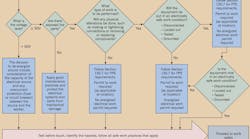In the April issue of EC&M, we discussed establishing an electrically safe work condition. But what happens if you can’t establish such a condition? That’s where NFPA 70E, Art. 130 comes in to play.
It tells you when an electrically safe work condition must be established [130.1(1)] and then covers the electrical safety-related work practices for when that condition cannot be established [130.1(2)].
(Click here to see a PDF version of the Energized Electrical Work Permit Flow Chart)
Although it’s not split into two parts, Art. 130 logically can be. The second part [130.7] provides the requirements for personal protective equipment (PPE) and other protective equipment. The first part [130.1 through 130.6, plus 130.8, 9, and 10] provides the requirements for such things as work permits, approach boundaries, and precautions for personnel activities. This first part is what we’ll cover here.
Working hot
You don’t perform energized work simply because your boss wants you to, it’s quicker, or you “know what you’re doing.” You can perform energized work only if one (or more) of three conditions applies [130.2(A)]:
- The employer can demonstrate that de-energizing introduces additional hazards or increased risk.
- The employer can demonstrate it’s infeasible to perform the work in a de-energized state due to equipment design or operational limitations.
- The circuits operate at less than 50V. This is contingent upon the capacity of the source and any overcurrent protection between the source and the worker; there must be a determination that there will be no increased exposure to electrical burns or explosion due to electric arcs.
The Informational Notes below these conditions provide examples to help illustrate what’s meant.
Normal operation
Understanding the concept of “normal operation” is critical to correctly applying the requirements of Art. 130. Actually verifying normal operation may require some serious sleuthing. If you’re a contractor, don’t just ask about the maintenance of the equipment — insist on seeing the maintenance records.
All five of the following conditions must be met, or you must consider the equipment to be operating abnormally [130.2(A)(4)]. The equipment:
- Is properly installed.
- Is properly maintained.
- Doors are closed and secured.
- Covers are in place and secured.
- Shows no evidence of impending failure.
The Informational Note following this list explains what’s meant by properly installed and properly maintained. In essence, both activities were performed per industry standards. The Informational Note also provides some explanation of what “evidence of impending failure” means.
Don’t assume the short paragraph that constitutes this Informational Note tells you everything you need to know. Use it as a starting point. Ask more questions, such as:
- What equipment anomalies indicate failure?
- What standards are used for maintenance, and do the maintenance procedures align with those?
- Is the “qualified worker” standard strictly enforced, or do inadequately trained people perform maintenance work?
Energized electrical work permit
A qualified person doesn’t need an electrical work permit to do any of the following [130.2(B)(3)]:
- Perform tests and/or measurements.
- Conduct thermography.
- Enter/exit area with energized equipment, if not performing electrical work in that area and not crossing the restricted approach boundary.
- Conduct general housekeeping and/or miscellaneous non-electrical tasks (and not crossing the restricted approach boundary).
Most people view a work permit as something that gives them permission to do the work. Instead, think of a work permit in the opposite way. You aren’t filling out the permit to get permission; you are filling it to give permission.
With this perspective, you will look for dangers rather than see what you can get by with. Someone else may sign the official approval, but you are the one who will pay the real price if something happens. Put yourself in charge of ensuring the conditions of that permit are properly met.
An electrical work permit has, at a minimum, the eight elements enumerated in 130.2(B)(2)(1) through (8). Consider number 7, which is “Evidence of completion of a job briefing, including a discussion of any job-specific hazards.” If you weren’t in charge of the permit (traditional viewpoint), you might seek some quick “check the box” way of satisfying this requirement so you can get on with the job.
But since you are in charge of the permit, that’s not what you want. Is that briefing sufficient if it’s just a quick summary with a sign-off sheet? No, you want to understand the job and its hazards. You want to be able to not only outline the major steps, but also identify how to protect against every known hazard any of those steps might bring.
If you take ownership of each element of that permit, are you going to have a happy boss or an unhappy boss? Let’s see. You are taking personal responsibility to ensure something extremely bad doesn’t happen. What competent boss would not be thrilled with this?
If you view the permit as an obstacle, then your boss is tasked with trying to make sure you comply. That’s just more work for your boss, and it leaves you at a higher level of risk.
Approach boundaries
How close can you get to the energized equipment? The answer to this question is only as close as your shock protection boundary allows. There are two kinds of shock protection boundary: limited and restricted [130.4(B)]. In either case, the distances must be established using Table 130.4(D)(a) for AC voltages or Table 130.4(D)(b) for DC voltages.
The limited approach boundary applies to unqualified personnel. There is some confusion on what this means. It’s not just a matter of expertise; you are also unqualified if you don’t need to be there. Generally, if you don’t have specific assignments on the other side of that boundary then don’t cross that boundary.
Circumstances do arise where an unqualified person needs to cross that boundary. That person probably hasn’t had the job briefing and so would be unfamiliar with the hazards. This in itself creates a dangerous situation.
The solution in NFPA 70E is that a qualified person advises the unqualified person of the possible hazards and escorts that person at all times [130.4(C)(3)]. That unqualified person cannot, however, cross the restricted approach boundary regardless of “need.”
The privilege of crossing the restricted boundary is restricted to qualified people. But even they must work under restrictions after having crossed that boundary. They can’t approach (or take any conductive object) closer to exposed energized conductors (50V or more) than the distance(s) set forth by Table 130.4(D)(a) or (b), unless the following conditions are met:
- The person is insulated from or guarded from the energized conductors.
- The person is insulated from any other conductive object.
- The energized conductors are insulated from any other conductive object that’s at a different potential.
Arc flash
Another boundary on the job is the arc flash boundary. An arc flash study must be conducted to determine where this boundary is [130.5(1).b]. As a result of this study, which is documented, workers will know what PPE and work practices are required for them to be able to cross that boundary.
Determining the arc flash boundary is complicated. Informative Annex D, which runs nine pages, explains how to do this.
Let it shine
Electrical testing firms and electrical service firms have long considered rental of lights and generator a normal part of switchgear work. In most facilities, the lights for the switchgear are supplied by that switchgear instead of by another source. The logic of this has escaped explanation.
Where lighting is present, it’s typically inadequate for working inside the cabinets. It’s just ambient lighting and not intended to facilitate work — no logical explanation for that, either.
If a poor lighting situation exists, it must be corrected (e.g., with portable lights) before work may be performed. In fact, employees cannot even enter spaces where electrical hazards exist unless there is sufficient illumination to perform the work safely [130.6(C)(1)].
Having a helper stand there with a D-cell flashlight doesn’t count as providing illumination. The area should be lit up with work lamps. And you’ll have to light around obstructions so there aren’t shadows creating optical illusions or other visual difficulties. Typically, this will mean running several cords across the floor. Cord management is a safety issue; therefore, tape those cords down, and use cord protectors so that people don’t trip.
Other precautions
You’ll find other precautions listed in 130.6, such as:
- Be alert at all times when within the limited approach boundary. Note that you can’t be alert if you’re fatigued. It’s better to call it a day than to make this your last day.
- Don’t reach blindly into cabinets or other places that might contain energized conductors or circuits.
- Don’t wear conductive items such as jewelry.
- Where there is evidence that electrical equipment could fail, shut it down unless the employer can demonstrate that de-energization poses a greater hazard.
While Art. 130 provides a good basis for working safely around electrical hazards, it is by no means a substitute for diligently analyzing every work situation. Never take anything for granted, and never accept “that’s good enough” as a substitute for properly implementing safety principles.
Lamendola is an electrical consultant located in Merriam, Kan. He can be reached at [email protected].




